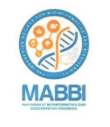DETEKSI GEN MSG UNTUK PENINGKATKAN KETEPATAN DIAGNOSIS PNEUMOCYSTIS JIROVECII PADA PASIEN HIV DENGAN PNEUMONIA
Abstract
Full Text:
PDFReferences
Alison M dan Karen AN. (2012). Colonization by Pneumocystis jirovecii and Its Role in Disease. J Clin Microbiol Rev.; 25(2):297-317
Alison M, Kenneth W, Kamyar A, and Laurence H. (2008). Epidemiology and Clinical Significance of Pneumocystis Colonization. J Infect Dis.; 197:10 –7
Anaissie EJ, McGinnis MR, and Pfaller MA.(2009). Clinical Mycology. Churchill Livingstone 1st Edition. Elsevier.
Babic EA, Vilibic CT, Erceg M, Mlinaric ME and Begovac J. 2014. Prevalence of Pneumocystis jirovecii Pneumonia (2010-2013): The First Croatian Report. Acta Microbiol Immunol Hung; 61 (2): 181-8
Calderon EJ, Varela JM, Joly ID, and Cas ED. (2011). Pneumocystis jirovecii Pneumonia. ISBN: 978-1-61209-685-8.
Catharina F, Jacobs JA, Becker P, Templeton KE, Bakkers J, Kuijper EJ. (2006). Interlaboratory Comparison of three Different real time PCR Assay for detection of Pneumocystis jirovecii in Bronchoalveolar Lavage Fluid Samples. J Med Microbiol; 55(pt9): 1229-35
Catherinot E, Lanternier F, Bougnoux ME, Lecuit M, Couderc LJ, and Lortholary O. (2010). Pneumocystis jirovecii Pneumonia. Infect Dis Clin North Am.; 24 (1): 107-38
CDC. Pneumocystis: Pneumocystis jirovecii. DPDx.Unduhhttp://www.cdc.gov/dpdx/pneu mocystis/. 8 agustus 2015
Dohn MN, White ML, Vigdorth EM, Ralph BC, Hertzberg VS, Baughman RP. (2000). Geographic clustering of Pneumocystis carinii pneumonia in patients with HIV infection. Am J Respir Crit Care Med; 162:1617.
Epsy MJ, Uhl JR, SloanLM. 2006. Real-Time PCR in Clinical Microbiology: Application for Routine Laboratory Testing. Clin Microbiol Rev;19(1):165-256
Francisco JM, Marco MC, Conde M, Carmen de la H, Respaldiza N, Antonia G, (2005). Pneumocystis jirovecii in General Population. Emerg Infect Dis.; 11(2): 245-250
Jackop Frans. (2004). Genetic Investigation of Pneumocystis jirovecii: Detection, Cotrimoxazol Resistence and Population Structure. University of Stellenbosch.. Unduh 21 April 2015
Krajicek BJ, Limper AH, and Thomas CF Jr. (2008). Advances in the biology, pathogenesis and identification of Pneumocystis pneumonia. Curr Opin Pulm Med.; 14(3):228-34.
Kutty G, Maldarelli, Achaz G and tin. (2008). The Major Surface Glycoprotein Genes in Pneumocystis jirovecii. J infect Dis; 198(5): 741-749
Munshi A. (2012) DNA Sequencing Methods and Application. ISBN. Unduh http://library.umac.mo/ebooks/b28050393.pdf . 4 Juni 2016
Qiagen. PCR Protocol and Application. https: // www.qiagen.com /resources/ molecularbiology-methods/pcr/. Unduh 3 Juni 2016.
Robert GF, Belaz S, Revest M, Tattevin P, Jouneau S, Decaux O. (2014). Diagnosis of Pneumocystis jirovecii Pneumonia in Immunocompromised Patients by Real-Time PCR: a 4-Year Prospective Study. J Clin Microbiol; 52(9): 3370–3376.
Rodriguez YDA, Wissmann G, Muller AL, Pederiva MA, Brum MC, Brackmann RL. (2011). Pneumocystis jirovecii Pneumonia in Developing Countries. J Parasite.; 18(3): 219228
Rozaliyani A.(2009). Karakteristik klinis, radiologis dan laboratoris pneumonia Pneumocystis pada pasien AIDS dengan gejala pneumonia di beberapa rumah sakit di Jakarta. Jakarta: Medical Research Unit FKUI;.h. 22-51
Stansell JD, Osmond DH, Charlebois E, LaVange L, Wallace JM, Alexander BV. (1997). Predictors of Pneumocystis carinii pneumonia in HIV-infected persons. Pulmonary Complications of HIV Infection Study Group. Am J Respir Crit Care Med.; 155(1): 60-6.
Thermo Scientific. T042 Techmical Bulletin NanoDrop Spectrophotometer: Assesment of Nucleic Acid Purity. Unduh http://www.nanodrop.com/Library/T042NanoDrop-Spectrophotometers-Nucleic-AcidPurity-Ratios.pdf. 2 mei 2016.
Walker J, Corner G, Ho J, Hunt C, and Pickering L. (1989). Giemsa Staining for Cysts and Trophozoites of Pneumocystis carinii. J Clin Pathol; 42(4):432-4
DOI: https://doi.org/10.47007/ijobb.v2i1.22
Refbacks
- There are currently no refbacks.
| Indonesian Journal of Biotechnology and Biodiversity Published by: Publishing Department of Esa Unggul University Arjuna Utara No 9 Street Kebon Jeruk Jakarta - 11510 Indonesia | |








.png)

